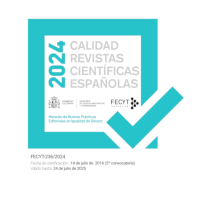Learning the Part-Whole Model of Fractions Through a Task with Flags of The World
DOI:
https://doi.org/10.18172/con.6499Keywords:
rational numbers, basic education, teacher training, problem-solving strategies, part-whole modelAbstract
This article aims to present a contextualised task for learning the part-whole model of fractions based on the use of national flags, and to analyse the resolution strategies and levels of difficulty that arise from its implementation in different educational contexts. The results obtained are analysed from a qualitative phenomenological approach, obtaining evidence of the level of reasoning about fractions put into practice. The task, originally designed for compulsory basic education, is based on the question What fraction of the flag occupies the colour red? in front of a selection of different flags. In order to identify specific fraction calculation strategies, this task was implemented with students in basic education and both pre-service and in-service teachers in Spain and Portugal. Six different resolution strategies were identified: visual, decomposition, recomposition, operational, measurement with a graduated ruler and fractional measurements. Likewise, different levels of difficulty were identified depending on whether the flags require graphic strategies or knowledge of geometric properties to calculate the fraction. The proposal favours the development of skills in the calculation, measurement and estimation of fractions and is adaptable to different grades, from 3rd year of primary or basic education onwards, by modifying the selection of flags. The predominance of visual, decompositional and operational additive strategies was observed among students and trainee teachers. The transformation of geometry by recomposition and the use of a graduated ruler to calculate triangular areas were also observed in pre-service and in-service teachers. Notably absent across all participant groups were fractional measurement strategies, as well as subtractive, multiplicative, and quotient-based approaches.
Downloads
References
Battista, M. T. (2012). Cognition-based assessment & teaching of fractions: building on students’ reasoning. Heinemann.
Bicudo, M. A. V. (2006). Pesquisa Qualitativa e Pesquisa Qualitativa segundo a abordagem fenomenológica. En M. C. Borba y J. L. Araújo (Orgs.), Pesquisa Qualitativa em Educação Matemática (pp. 101-116).
Choi, J.-I. y Hannafin, M. (1997). The effects of instructional context and reasoning complexity on mathematics problem-solving. Educational Technology Research and Development, 45(3), 43-55. https://doi.org/10.1007/BF02299728 DOI: https://doi.org/10.1007/BF02299728
de la Cruz Rodríguez Rojas, P. y Navarrete Rojas, C. A. (2020). Influencia del conocimiento profundo del profesor sobre fracciones en el aprendizaje de alumnos de 4o grado. Revista Electronica de Investigacion Educativa, 22(1), 1-18. https://doi.org/10.24320/REDIE.2020.22.E10.2285 DOI: https://doi.org/10.24320/redie.2020.22.e10.2285
Graça, S. y Guerreiro, A. (2016). Bandeiras dos Países: Recurso para o ensino dos racionais. En A. P. Canavarro, A. Borralho, J. Brocardo y L. Santos (Eds.), Livro de atas do EIEM 2016. Encontro de Investigação em Educação Matemática (pp. 129-141). SPIEM.
Graça, S., Da Ponte, J. P. y Guerreiro, A. (2021). Quando As Frações Não São Apenas Partes de Um Todo…! Educação Matemática Pesquisa : Revista Do Programa de Estudos Pós-Graduados Em Educação Matemática, 23(1), 683-712. https://doi.org/10.23925/1983-3156.2021v23i1p683-712 DOI: https://doi.org/10.23925/1983-3156.2021v23i1p683-712
Guerreiro, C. (2023). Números Racionais: um estudo com bandeiras de países no 2.º ciclo do ensino básico. (Relatório de Prática de Ensino Supervisionada, Universidade do Algarve). Repositório da Universidade do Algarve.
Iuculano, T. y Butterworth, B. (2011). Rapid Communication: Understanding the Real Value of Fractions and Decimals. Quarterly Journal of Experimental Psychology, 64(11), 2088-2098. https://doi.org/10.1080/17470218.2011.604785 DOI: https://doi.org/10.1080/17470218.2011.604785
Kieren, T. E. (1980). The Rational Number Construct: Its Elements and Mechanisms. En T. E. Kieren (Ed.), Recent Research on Number Learning (pp. 125-150). ERIC Clearinghouse for Science, Mathematics, and Environmental Education.
Lamon, S. J. (2020). Teaching Fractions and Ratios for Understanding. Routledge. https://doi.org/10.4324/9781003008057 DOI: https://doi.org/10.4324/9781003008057
Makhubele, Y. E. (2021). The Analysis of Grade 8 Fractions Errors Displayed by Learners Due to Deficient Mastery of Prerequisite Concepts. International Electronic Journal of Mathematics Education, 16(3), em0645. https://doi.org/10.29333/iejme/11004 DOI: https://doi.org/10.29333/iejme/11004
Martínez Jiménez, E., Nolla de Celis, Á. y Fernández de Ahumada, E. (2022). The City as a Tool for STEAM Education: Problem-Posing in the Context of Math Trails. Mathematics, 10(2995), 1-17. https://doi.org/https://doi.org/10.3390/math10162995 DOI: https://doi.org/10.3390/math10162995
Ministério da Educação (2021). Aprendizagens Essenciais da Matemática. Editorial do Ministério da Educação – Direção Geral da Educação.
Monteiro, C. y Pinto, H. (2005). A Aprendizagem dos números racionais. Quadrante, 14(1), 89-107.
National Council of Teachers of Mathematics (2007). Princípios e Normas para a Matemática Escolar. APM - NCTM.
Norton, A. y Wilkins, J. L. M. (2012). The Splitting Group. Journal for Research in Mathematics Education, 43(5), 557-583. https://doi.org/10.5951/jresematheduc. 43.5.0557 DOI: https://doi.org/10.5951/jresematheduc.43.5.0557
Real Decreto 157/2022, de 1 de Marzo, por el que se establecen la ordenación y las enseñanzas mínimas de la Educación Primaria, 24386 (2022). https://www.boe.es
Siebert, D. y Gaskin, N. (2006). Creating, Naming, and Justifying Fractions. Teaching Children Mathematics, 12(8), 394-400. http://www.jstor.org/stable/41198803
Torbeyns, J., Schneider, M., Xin, Z. y Siegler, R. S. (2015). Bridging the gap: Fraction understanding is central to mathematics achievement in students from three different continents. Learning and Instruction, 37, 5-13. https://doi.org/10.1016/j.learninstruc.2014.03.002 DOI: https://doi.org/10.1016/j.learninstruc.2014.03.002
Downloads
Published
How to Cite
Issue
Section
License
Copyright (c) 2025 António Guerreiro, Enrique Martínez Jiménez

This work is licensed under a Creative Commons Attribution 4.0 International License.
The authors retain copyright of articles and authorize Contextos Educativos. Revista de Educación the first publication. They are free to share and redistribute the article without obtaining permission from the publisher as long as they give appropriate credit to the editor and the journal.
Self-archiving is allowed too. In fact, it is recommendable to deposit a PDF version of the paper in academic and/or institutional repositories.












